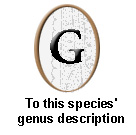

|
Syn.:
|
Vibrio agrostis Steinbuch, 1799
Anguillula agrostis (Steinbuch) Ehrenberg, 1838 Tylenchus agrostis (Steinbuch) Goodey, 1930 Anguillulina agrostis (Steinbuch) Goodey, 1932 Vibrio phalaridis (Steinbuch) Ehrenberg, 1838 Anguillula phalaridis (Steinbuch) Ehrenberg, 1838 Tylenchus phalaridis (Steinbuch) Orley, 1880 Anguillulina phalaridis (Steinbuch) Goodey, 1932 Anguina phalaridis (Steinbuch) Chizhov, 1980 Tylenchus agrostidis Bastian, 1865 Anguillula agrostidis (Bastian) Warming, 1877 Tylenchus phlei Horn, 1888 Anguina poophila Kirjanova, 1952 Anguina lolii Price, 1973 (=nomen nudum) |
|
|
Description (after Chizhov, 1980): Females: Body spirally coiled
or crescentic (C-shaped). Cuticle with fine annulation. Lip region
set off, 3-4 um high. Procorpus cylindrical, somewhat enlarged
in the middle part with a constriction before joining median bulb.
The latter ovoid. Isthmus short and narrow. Basal bulb well
developed, trapezoid, although not overlapping the intestine. The
maximum width of the body in specimens parsitizing Poa spp or Phleum
phleoides is reached at the level immediately behind the esophagus.
In more slender specimens from Agrostis (bent grass) the maximum
width of the body is reached only at the level of spermatheca. Ovary
reflexed two or three times. Oocytes in the zone of multiplication
in two or three rows. Spermatheca elongate, sometimes with up to10-12
synchronous oocytes, separated from the preuteral gland by a short constriction.
Preuteral gland long, with up to 20 synchronous egg, separated from the
uterus by a constriction (oviduct). Postvulval uterine branch reaching
half the distance from the vulva to anus, filled with sperms. Tail
short, conoid, with acute terminus.
Males: Body after heat relaxation almost outstretched. Testis
usually with one or two flexures. Bursa subterminal, does not reach
the tail tip.
Hosts: Agrostis tenuis Sibth. (type host). Besides various
bent grass species, this nematode is reported from other grass genera,
including Apera, Arctagrostis, Calamagrostis, Dactylis,
Eragrostis, Festuca, Hordeum, Koeleria, Lolium.
Phalaris, Phleum, Poa, Puccinellia, Sporobolus,
and Trisetum (Kirjanova and Krall, 1971; Southey, 1973).
Bionomics: Second-stage juveniles hatch and invade young grasses early
in May (Europe) or at the end of August (Australia). The juveniles
migrate to the inflorescence and incite seed galls. Heavily infested
grasses have been repeatedly mistakenly described by botanists as new species
or forms (f. vivipara a.0.) Maturation and oviposition began at
mid-June in European countries. In Australia, new juveniles begans
to hatch in the middle of October. Only one generation develops per
year.
Anguina agrostis is considered to be a serious or potentially
important nematode pest of bent grass, especially in the Pacific Northwest
USA and New Zealand (Southey, 1973). Fresh galls of A. agrostis
from chewing's fescue have been found to be poisonous to cattle and sheep
in the USA and this species (= A. funesta) is known also as the
vector of annual rye grass toxicity in Australia (Kirjanova and Krall,
1971; Southey, 1973; McKay a.o., 1981).
Distribution: Europe, Asia, (the far east of the USSR), North America
(USA and Canada), Australia, New Zealand, South Africa.
(Description- Raski in Manual of Agricultural Nematology)
DNA Sequences Obtained
| Specimen: | Collected: |
| 442 Drawer-30 | Laboratory specimen |
 |
 |